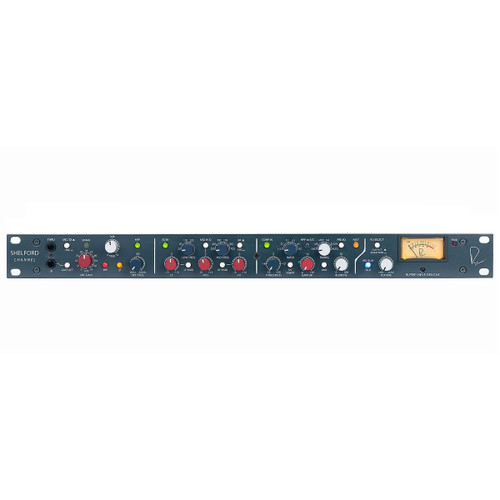The Rupert Neve Shelford 5051 Inductor EQ & Compressor combines a classic three band EQ based on Rupert Neve vintage designs with the power and flexibility of the Portico II compressor. Utilizing a fully-discrete, class-A signal path and high performance input and output transformers, the 5051 delivers the performance and musicality expected from a Rupert Neve Design.
The Equalizer
The EQ design on the 5051 evokes sonic similarities with some of Rupert's classic EQs. The 5051 uses a custom tapped inductor with selected capacitors to form the mid range equalizer band, and the shelf curves are based on Rupert's vintage modules, including very similar frequency choices. Each EQ section also uses low feedback class-A discrete electronics to prevent low level artifacts and harshness from detracting from the tonal shaping. The EQ, however, is a modern design with advantages offered by techniques that were not possible 35 years ago along with improvements in electronic components currently available, and should not be considered a clone. Let's just say it has heritage.
The Compressor
The 5051 Compressor also features a discrete class A signal path proven used in the Portico Series, with individually controllable threshold, attack, release, makeup gain, ratio, side chain HPF, Feed-Forward / Feed-back selection and Peak/RMS detection modes. With the compressor inactive, the 5051 may be used as a transformer-coupled, high-performance line amplifier, and two 5051's may be linked for stereo operation as well.
Feed-Forward or Feed-Back?
The 5051 also has the ability to switch between feed-forward and feed-back modes. If the V.C.A. Control voltage is taken from the 5051 output, (i.e. after the V.C.A.) it cannot act immediately on the V.C.A. because it has already been modified by settings of the V.C.A. and circuits through which it has passed. This is known as a "Feed-Back" compressor. The two compression characteristics are quite different; there is more "Overshoot" and both the attack and recovery ramps are changed, providing the user with powerful choices. In most of Mr. Rupert Neve's earliest designs, feed-back detection controlling the VCA with a rectified voltage from the unit output was intrinsic to the musical dynamic response. However, the very nature of a feedback compressor limits the attack time of the compression circuit. To offer faster, more technically accurate response times, feed-forward detection was implemented on Mr. Rupert Neve/s more modern designs. With the FF / FB switch, both classic and modern VCA responses are available.
Ratio and Threshold
Above a given "THRESHOLD" signals are reduced by an adjustable amount ranging from 1:1, (which is linear, or no reduction at all), to more than 40:1 which is a very high ratio, equivalent to that of a Limiter. RATIO is sometimes referred to as Slope because when depicted on a graph, the slope of the graph representing Output versus Input, is what changes. Ratio and Threshold are closely inter-dependent. If a RATIO as high as 40:1 has been set, then if the THRESHOLD is set at 0 dBu, even when a massive signal of +40 dBu (unlikely!) is presented to the input, the output signal will only be +1 dBu. RATIOS as high as this would normally be set somewhere above 0 dBu say at +14 dBu, in order to prevent the output signal level exceeding just over +14 dBu to protect, for example, a digital recorder. Similarly, if a RATIO of 5:1 has been set, an input signal which is 10dB above THRESHOLD will only rise by 2dB above that THRESHOLD at the output. THRESHOLD control covers the Range from below -30dB to +22dBu. When THRESHOLD set at a low level, with a fairly high RATIO the amount of gain reduction will be considerable and it may be necessary to use some GAIN after the compressor to restore the apparent signal level.
Attack Time
The ATTACK time is the time taken for the compression circuits to start compressing. A long ATTACK time allows short duration peaks to escape and go through uncompressed. This may cause overload on subsequent digital circuits. A very short attack time sounds un-natural and robs the signal of life by removing transients. Some transients are extremely fast and have little effect on the sound quality. Setting a long attack time often means that almost no gain reduction occurs because the transient is history (!) before compression has had time to operate. However, even the fastest circuits take time to operate which means that there is always some Overshoot. Small amounts of Overshoot are musically desirable there are exceptions, of course. Setting the right values of RELEASE and ATTACK is what compression is all about! Once the principles are understood a Compressor-Limiter such as the 5051 provides a powerful tool that actually appears to enhance the dynamic range of a recording and so provide greater musical enjoyment.
Release / Recovery
The notes above explain how the 5051 handles signals of constant amplitude such as pure tones. Real program signals, however, are continually changing in level. The way in which a compressor deals with actual program material depends upon the magnitude and duration of peaks in the program level. If the RELEASE TIME is set to be very short, a short duration signal will be compressed but the gain will return to normal very quickly, giving a fluctuating and un-natural sound known as Pumping when the background, or other signals, are forced up and down. The gain will also tend to follow the wave form of low frequency signals. RELEASE TIME should be set long enough for the gain to remain reasonably constant between each bass note or between speech syllables.
The Power Supply
The 5051 is intended for 5088 consoles or 5285 vertical frames. There are two +/- 24V power supply options; The 5-way supply is designed to sit in the bottom of a rack, and the 25-way supply is a 2U enclosure. The external +/- 24V supply provides exceptionally clean power, and reduces heat build-up within modules associated with DC-DC up-conversion.
Rupert Neve Shelford 5051 Inductor EQ & Compressor Features
- MIC GAIN - A 12-way precision rotary switch controls gain from 0 to 66 dB in 6 dB steps.
- TRIM - Continuously variable +/-6 dB level control.
- +48V - Engages phantom power on the microphone input, as supplied by the 500 series rack.
- POLARITY - Push button inverts the polarity of the signal path, and illuminates when engaged. The symbol Ø is often used to denote opposite polarity.
- HIGH PASS FILTER - The high pass filter is continuously variable from 20-250Hz and engaged by the HPF switch, which illuminates when engaged. It is a valuable aid in any signal chain, but particularly so in a microphone preamplifier. Signals below the selected frequency are attenuated at a rate of 12db / octave, getting rid of proximity effect, building rumble, air handling, motor hum, etc.
- SILK / TEXTURE - Pushing the Silk button engages the red Silk circuit, which reduces the negative feedback on the output transformer, adding harmonic content as the texture is increased. Red Silk accentuates the saturation in the mid and high frequencies, similar to that of the red silk mode on the Portico II Channel. By manipulating the Texture control, the amount of Silk can be changed from essentially absent, to roughly 10 times the amount of coloration / distortion found in Silk from the original Portico Series. With Silk / Texture engaged, the distortion characteristic and harmonic content of the unit are very reminiscent of many of Rupert's class-A vintage designs.
- LEVEL METER - An Eight-segment LED bar-graph meter displays output level (pre-Silk). The color range proceeds from green for lower level signals, yellow for intermediate signals, and red for high levels. When the 511 is clipped, the highest red LED will hold longer depending on how far above the clip threshold the signal was.
Rupert Neve Shelford 5051 Inductor EQ & Compressor Specifications
- Frequency Response: Main Output, no load
- 3 dB @ 2.5 Hz
- 3 dB @ 125 kHz
- Noise: Measured at Main Output, unweighted, 22Hz-22kHz, Terminated 40 Ohms, With gain at unity
- better than 102 dBu
- Maximum input: from 20 Hz to 20 kHz, +25 dBu.
- Maximum output: from 20 Hz to 20 kHz is +25 dBu. Total Harmonic Distortion and Noise: from <10 Hz to 80 kHz,
- @ 1kHz, +20 dBu output: Better than 0.002% @ 20Hz, +20 dBu out Better than 0.120%, 13
- @ 20kHz, +20 dBu out Better than 0.010%
- Maximum input: from 20 Hz to 20 kH, +24.5 dBu
- Maximum output: from 20 Hz to 20 kHz, +24.5 dBu
- Total Harmonic Distortion and Noise: from <10 Hz to 80 kHz, @ 1kHz, +20 dBu output:
- Better than 0.007% @ 20Hz, +20 dBu out
- Better than 0.120% @ 20kHz, +20 dBu out
- Better than 0.070%
- The Equalizer
- Noise: Measured at Main Output, unweighted, 22Hz-22kHz, Terminated 40 Ohms. with all gains set at 0, Better than -92 dBu
- Maximum input: from 20 Hz to 20 kH, +24.5 dBu
- Maximum output: from 20 Hz to 20 kHz, +24.5 dBu Total Harmonic Distortion and Noise: from <10 Hz to 80 kHz
- Noise: Measured at Main Output, unweighted, 22Hz-22kHz, Terminated 40 Ohms. Better than -92 dBu
- Maximum input: from 20 Hz to 20 kHz, +25 dBu.
- Maximum output: from 20 Hz to 20 kHz, +25 dBu.
- Total Harmonic Distortion and Noise: from <10 Hz to 80 kHz
- The Compressor (Threshold at +20 dB, Ratio at 1.1:1, Gain at 0)
- Noise: Measured at Main Output, unweighted, 22Hz-22kHz, Terminated 40 Ohms.
- Maximum input: from 20 Hz to 20 kHz, +25 dBu.
- Maximum output: from 20 Hz to 20 kHz, +25 dBu.
- Total Harmonic Distortion and Noise: from <10 Hz to 80 kHz
No review yet, Be first to Write a Review
Write a Review


















 Sign Up for exclusive sales and offers!
Sign Up for exclusive sales and offers!